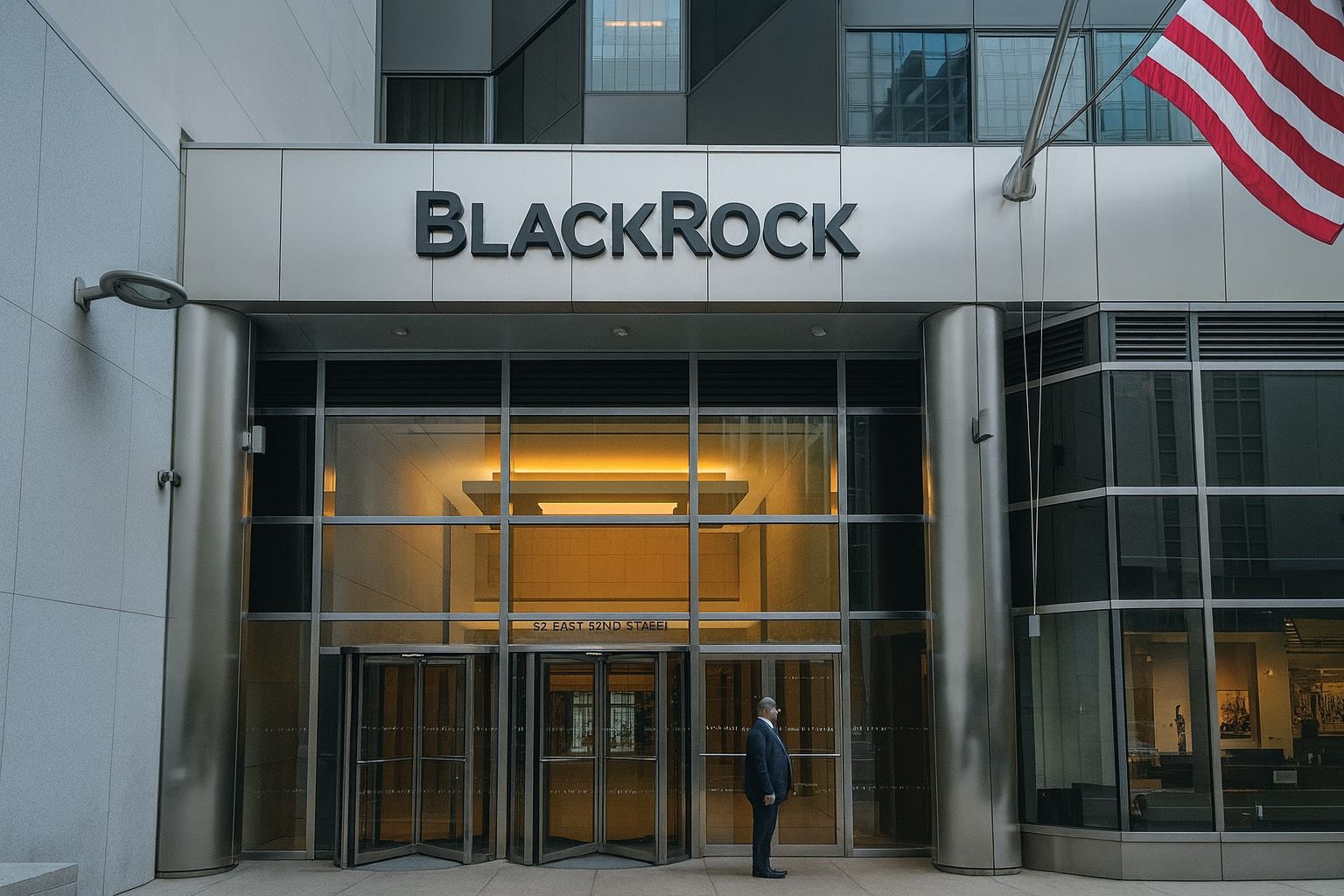- Breakthrough Deal: BlackRock’s infrastructure arm (Global Infrastructure Partners, or GIP) is in advanced talks to acquire power company AES Corp. in a deal worth roughly $38 billion (including debt) [1] [2]. Insider sources told the Financial Times and Bloomberg that the takeover could be announced imminently, though it is not yet final [3] [4].
- Stock Rally: News of the pending takeover sent AES shares soaring. AES stock jumped about 14% in pre-market trading on October 1, 2025 [5] (rising to ~$15 from the prior close of ~$13.16 [6]). This surge reflects excitement that GIP will pay a premium for the utility, even as the company’s share price has been under pressure.
- Deal Drivers: Investors note the timing is no accident. Surging demand for electricity from AI, cloud computing and data centers has spurred a wave of utility mergers [7] [8]. AES – which supplies renewable and traditional power to US and global customers, including tech giants’ data centers – fits squarely in that trend. As Reuters reported, “utilities are drawing investor interest as artificial intelligence and data centres drive a surge in power demand, spurring a wave of dealmaking” [9].
- Financials: AES has heavy debt: about $29 billion, versus a market capitalization near $9–10 billion [10] [11]. In other words, the enterprise value (~$38–41B) far exceeds its equity value. That leverage may let BlackRock capture AES at a relatively modest premium. Observers note AES’s stock has fallen roughly 30–35% over the past year, in part due to concerns about its renewable-heavy business and policy headwinds [12] [13].
- Analyst View: Despite recent volatility, most Wall Street analysts like AES. TipRanks shows 21 Buy vs. 7 Hold ratings on AES, implying a strong consensus to own the stock [14]. For example, Morgan Stanley’s David Arcaro in August reiterated a “Buy” rating on AES (target $23), praising its “solid financial performance” and strong renewable backlog [15]. Analysts point out that AES’s Q2 2025 results beat forecasts substantially, and that its power grid contracts (for companies like Google, Microsoft, Amazon) give it strategic value [16] [17].
Deal Details
According to people briefed on the matter, BlackRock’s GIP is “nearing” a ~$38 billion takeover of AES [18] [19]. This figure includes AES’s debt, reported to be about $29 billion [20]. In equity terms, AES’s market value was only around $9–10 billion before the news [21] [22]. GIP – a specialist infrastructure fund now owned by BlackRock – has declined to comment, and AES has also refused to comment on the rumors [23] [24]. Financial regulators have rules for such deals, but sources say the acquisition could close quickly under existing approvals, possibly within days [25] [26]. Bloomberg reported the talks are “advanced” and an agreement could be reached as early as this week [27], though it cautions the deal is not certain and could still fall apart.
If consummated, the transaction would be one of the largest infrastructure deals ever. (GIP itself took U.S. utility Allete private last year in a $6.2 billion deal with CPP Investments [28].) The Wall Street Journal’s Dow Jones newswire notes that “people familiar with the matter” say GIP may announce the bid for AES “within days,” emphasizing the speed of negotiations [29]. AES will likely be taken private if the deal goes through, meaning public shareholders will be bought out. No final price or structure has been disclosed; media reports simply peg the total value (debt-plus-equity) near $38 billion [30] [31].
Why AES? AI, Data Centers and the Renewables Edge
AES is a well-known electric power company with a global footprint. It owns/operates power plants and utilities in about 15 countries, with roughly 32 gigawatts of generation capacity [32]. Significantly, about half of AES’s generation mix is renewable (wind, solar and storage), with the rest mainly gas and some coal/oil [33]. AES serves ~2.5 million customers through six electric utilities and other contracts [34]. Crucially for GIP, AES has secured many large corporate power deals: its systems help power the data centers of Microsoft, Meta (Facebook) and Google among others [35].
Investors see AES as a direct play on the energy needs of the tech sector. Data centers and AI compute farms are voracious consumers of electricity. As TipRanks explains, “the surge in power needs driven by AI has prompted major infrastructure funds to invest heavily in data center capacity,” and buying AES would give GIP a foothold in that growth [36]. In short, AES’s renewable assets align with the broader energy transition trend. Industry analysts call this deal a “pivotal moment” in infrastructure consolidation and ESG-driven investing [37], since institutional capital is flocking to renewable assets.
At the same time, AES’s recent history makes it a target. Its stock suffered a ~35% slide over the last year as investors fretted about policy changes (like rollback of green tax credits) and project delays [38]. AES did post strong earnings – e.g. Q2 2025 results beat analysts and management affirmed full-year guidance – but the share price remained weak [39] [40]. In July, Bloomberg reported AES was exploring strategic options after attracting takeover interest [41]. (Investors such as Brookfield Asset Management and GIP themselves had been eyeing AES [42].) The renewable-heavy business, once a selling point, had become a concern amid rising interest rates and policy uncertainty – making AES both vulnerable to a buyout and cheaper to buy.
Market Reaction and Analyst Commentary
News of the takeover bid triggered an immediate stock pop. On October 1, AES shares leapt ~14% in pre-market and early trading, briefly touching ~$15 [43]. Equity commentators noted that even before the surge, AES was trading near its 52-week low of ~$9.46 [44]. The jump reflects both takeover premium expectations and a relief rally by holders. For reference, AES’s stock had traded in a ~$9.50–$20 range over the past year [45].
Analysts are mostly upbeat. As one market news report summarized, AES is riding a “turnaround” after a tough year [46]. Analysts point out that fundamentals remain solid: Morgan Stanley reiterated a Buy rating on AES in August, highlighting the firm’s “solid financial performance and strategic positioning” [47]. TipRanks notes that Wall Street consensus is firmly positive: out of 30 recent analyst ratings, 21 are Buys versus 7 Holds and only 2 Sells [48]. The average price target is about $16.60, implying ~26% upside from pre-news levels [49].
Experts also mention that BlackRock’s GIP is a fitting buyer. GIP was formed by BlackRock in 2024 and now manages ~$170 billion in infrastructure funds. It has built a record in utilities: in 2024, GIP (with CPP Investments) took Allete private for $6.2B [50]. Analysts say GIP’s scale and expertise mean it can effectively manage AES’s complex, global assets. As one industry write-up puts it, this deal “reframes AES’s path” and draws “renewed investor attention” [51]. In short, many observers see GIP as an ideal partner to expand AES’s renewable pipeline and stabilize its finances.
At the same time, some caution. No one has officially confirmed terms. Regulators (like the FERC in the U.S.) must approve the deal, and depending on how it’s structured, review could be needed. Market watchers recall that AES has heavy leverage: its debt-to-equity ratio is sky-high (nearly 9:1 by some metrics [52]). That debt was a key reason analysts believed “BlackRock may not need to pay a big premium” [53]. Indeed, with enterprise value at ~$38B (including debt) while equity value is ~$9–10B, bidders can pay less per share. Intellectia (citing MarketWatch) noted that the sheer size of the deal and AES’s share decline could deter competing bids, possibly giving GIP an edge on price [54].
Industry Context and Implications
This takeover is part of a broader utility M&A boom. Financial media highlight that flows into energy and infrastructure have been surging, driven by tech-sector demand and a quest for stable returns. The FT and Reuters have noted multiple large deals underway in the energy/utility space (e.g. Broadcom and Microsoft’s data centers, utilities consolidations) [55]. In their view, AES is the latest trophy: Reuters says “utilities are drawing investor interest” amid power demand spikes [56]. Some analysts call the AES bid a “landmark acquisition” and a bellwether for the energy transition [57].
Experts stress the ESG angle. AES’s renewables-heavy portfolio aligns with decarbonization goals (AES touts commitments to cut emissions). BlackRock itself emphasizes ESG, though its critics note the firm has softened climate activism recently [58]. Acquiring AES would add ~21 GW of renewable assets to GIP’s holdings [59], reinforcing BlackRock’s “net-zero” messaging. But advocacy groups warn that piling critical infrastructure into a single fund can raise antitrust and public-interest issues [60]. In sum, the deal underscores tensions: it could accelerate clean energy projects, but also concentrates market power in a few hands.
For investors and analysts, the key next steps are clear. Watch for a firm announcement or deal press release. If GIP confirms the bid, we’ll learn the offered price per AES share and details of the financing. That will determine the premium (some expect maybe 20–30%). Regulatory review is likely more of a formality unless competition issues arise. In the meantime, AES’s stock may trade higher on buyout speculation, while peer utilities could also move on takeover chatter.
Bottom line: BlackRock’s near-miss on AES is already shifting markets. As one analysis put it, the move “marks a seismic shift in institutional capital allocation to energy transition assets” [61]. The deal fits squarely with the current narrative – tech drives power demand, renewable assets are scarce, big funds are ready to deploy capital – and could accelerate further consolidation. For now, no announcement is official, but if this $38B takeover completes, it will reshape AES’s future and send a strong signal that utilities are once again a hot spot for dealmakers in the AI age [62] [63].
Sources: In-depth news reports from Reuters [64] [65], Bloomberg News [66] [67] and related outlets [68] [69] [70]. Interviews and filings are ongoing; quotes above are drawn from published analyses and financial commentary.
References
1. www.investing.com, 2. www.marketscreener.com, 3. www.investing.com, 4. news.bloomberglaw.com, 5. tokenist.com, 6. tokenist.com, 7. www.investing.com, 8. news.bloomberglaw.com, 9. www.investing.com, 10. www.gurufocus.com, 11. intellectia.ai, 12. www.gurufocus.com, 13. www.tipranks.com, 14. www.tipranks.com, 15. finviz.com, 16. finviz.com, 17. www.tipranks.com, 18. www.investing.com, 19. www.marketscreener.com, 20. www.gurufocus.com, 21. tokenist.com, 22. www.gurufocus.com, 23. www.investing.com, 24. www.marketscreener.com, 25. www.marketscreener.com, 26. news.bloomberglaw.com, 27. news.bloomberglaw.com, 28. www.investing.com, 29. www.marketscreener.com, 30. www.investing.com, 31. www.gurufocus.com, 32. www.gurufocus.com, 33. www.gurufocus.com, 34. www.gurufocus.com, 35. www.tipranks.com, 36. www.tipranks.com, 37. www.ainvest.com, 38. www.tipranks.com, 39. www.investing.com, 40. finviz.com, 41. www.bloomberg.com, 42. www.bloomberg.com, 43. tokenist.com, 44. tokenist.com, 45. tokenist.com, 46. tokenist.com, 47. finviz.com, 48. www.tipranks.com, 49. www.tipranks.com, 50. www.investing.com, 51. www.tipranks.com, 52. www.gurufocus.com, 53. intellectia.ai, 54. intellectia.ai, 55. www.investing.com, 56. www.investing.com, 57. www.tipranks.com, 58. www.ainvest.com, 59. www.ainvest.com, 60. www.ainvest.com, 61. www.ainvest.com, 62. www.tipranks.com, 63. www.ainvest.com, 64. www.investing.com, 65. www.investing.com, 66. www.bloomberg.com, 67. news.bloomberglaw.com, 68. tokenist.com, 69. www.tipranks.com, 70. finviz.com









